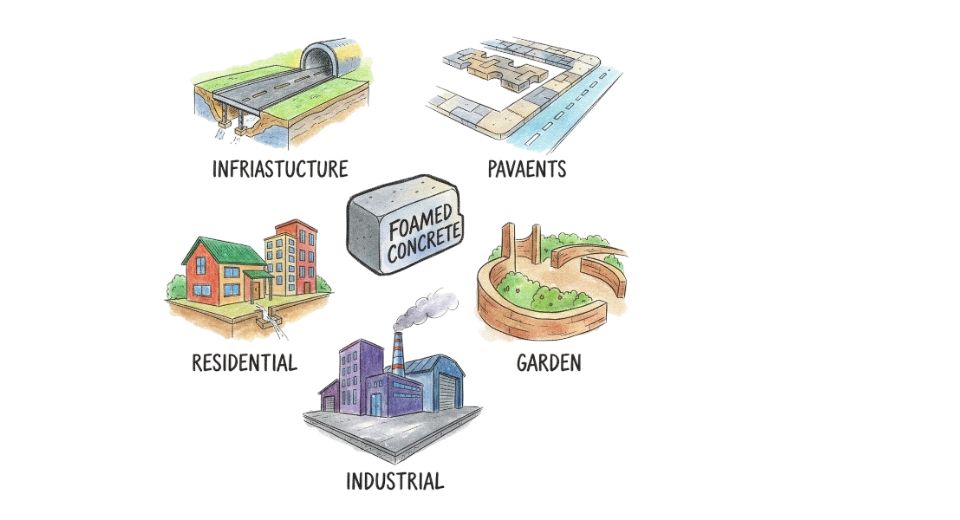
Nov 05, 2025

In an era where construction schedules are growing shorter, building materials have to provide more than mere strength lightness, sustainability and efficiency are required. The global foamed concrete market from Metastat Insight is ahead of the game in this revolution, providing solutions that are attuned to reality from quicker house construction in Indian suburbs to fills in deep voids under highways in the US. With the building sector adjusting to leaner budgets, more stringent environmental regulations and modular construction, this market is increasingly pertinent.
Market Context
The building sector today is facing increasing raw-material prices, congested city centers, and structural-load reductions with maintained performance. Traditional concrete tends to weigh more, require deeper foundations, and makes a significant contribution to embodied carbon. Step in foamed concrete: a lower-weight option that tackles several pain points. With its application, contractors are able to accelerate sub-base fills, fill structural gaps, and add insulation without compromising scale. Energy-efficient building and fast modular construction have created demand for this market, more than a niche it's becoming the basis for much modern construction.
How It Works and Why It's Valuable
Foamed concrete is produced through the addition of stable bubbles of air to a cementitious slurry, reducing density while maintaining the strength and thermal properties of the binder. Its worth derives from various benefits: lower structural load (which means thinner structural sections or reduced reinforcement), higher thermal and acoustic insulation, and simpler placement into difficult or restricted areas (e.g., around pipes or basement voids). Its reduced weight also translates to easier transport and lower foundation requirements. Additionally, since manufacturing can be integrated with industrial waste materials such as fly ash, it is more environmentally friendly in construction processes and is in line with carbon reduction strategies. All these features enable its use in precast wall panels, roof insulation material, road sub-bases and infill uses where regular concrete would be over-designed.
Evolution and Growth Story
First adopted in certain specialist applications e.g., back-filling, void filling or low-load panel construction the market has since migrated to more general-purpose use. Initial versions were constrained by instability of bubbles and inconsistent quality, but advances in foaming agents, mix design and process control have expanded its use. For instance, producers now supply self-leveling foamed concretes, and extended ranges of densities allow anything from insulation to structural infills. There is increasing adoption in residential and commercial markets as prefabricated and modular construction expand. Moving from exclusive specialist niche to mainstream choice in major projects is significant development for the market offered by Metastat Insight.
Regional and Global Trends
The strongest adoption is in countries with high infrastructure investment, modular home initiatives and sustainability goals. The Asia-Pacific is leading due to the pace of urbanisation, extensive housing programmes and policy initiatives towards green building. North America and Europe come next due to retrofit markets, renovations of old infrastructure and more stringent building standards. Emerging markets like South Asia, Latin America and the Middle East are demonstrating high-growth potential projects here tend to require budget-friendly, quick-to-install materials and so offer rich soil for this market's growth.
Challenges and Opportunities
Challenges persist. Foam quality control and uniformity of mixes are still issues for some producers, and the price of specialist foaming agents or portable mixing units can restrict take-up in less expensive areas. In addition, competition from conventional concretes, polystyrene blocks or other lightweight fillers ensures that persuading specifiers of value is a task. On the other hand, there are opportunities galore: the expanding need for energy-efficient buildings, the trend toward off-site and modular building, and incentives toward low-carbon materials. As design trends become more adept at leveraging lightweight concrete, the market opportunity offered by Metastat Insight can stand to gain both scope and depth of penetration into new applications.
Why It Matters Now
In the global sweep of trends sustainability requirements, digital construction, materials circularity this market is of concrete significance. Lightweight, low-carbon substitutes are no longer "nice to have" but obligatory in most jurisdictions. The global foamed concrete market presented by Metastat Insight allows for more flexible construction, less waste, faster delivery and lower environmental footprint. As cities continue to densify, infrastructure demands grow and retrofits are the norm, this material category is well-placed to shape the building future.
Drop us an email at:
Call us on:
+1 214 613 5758
+91 73850 57479